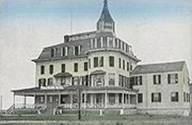The Table of Content


Family Research:









Available Help:



|
Newbury is a town in Essex County, Massachusetts. The population was 6,717 at the 2000 census. Newbury includes the villages of Old Town (Newbury Center), Plum Island and Byfield, home of The Governor's Academy (formerly Governor Dummer Academy), a private preparatory school.
Newberry Plantation was settled and incorporated in 1635. The Rev. Thomas Parker and cousin Rev. James Noyes along with his brother Nicholas Noyes led a group of approximately 100 pioneers from Wiltshire, England. They sailed from the River Thames aboard the ship Mary and John, first landing in Agawam (now Ipswich) in 1634. They arrived the next spring at the Quascacunquen River, now the Parker River. A commemorative stone marks the spot where Nicholas Noyes was the first of the new settlers to leap ashore at Newbury. The site had once been a village of the Pawtucket Indians, who hunted, fished or farmed. Many settlers would do the same. In 1791, 3,000 head of cattle grazed town lands, or on the region's abundant salt marsh hay. Other trades included tanning and shipbuilding. Newbury originally included Newburyport, set off in 1764, and West Newbury, set off in 1819.
Quascancunquen means "waterfall," referring to the falls in Byfield where Central Street crosses the Parker River. In 1636, the first water powered mill was established at the falls. Gristmills and sawmills were built, and in 1794, the first textile mill in Massachusetts. At Byfield in 1763 was founded the nation's first preparatory school, Dum'r (Dummer) Charity School, known subsequently as Dummer Academy, Governor Dummer Academy, and now The Governor's Academy. It was also site of the first female seminary, founded in 1807. Byfield developed into a mill village, and once had six water powered mills, manufacturing various products from woolens to snuff.
The railroad entered the community in 1850, carrying freight but also tourists, helping Plum Island develop into a Victorian seaside resort. Back on the mainland, silver was discovered in a large field in 1878, and the Chipman Silver Mine would begin operations until it finally closed in 1925. By 1905, however, the economy had shifted to back to agriculture, and Newbury became a supplier of eggs, milk and poultry. Some would dig for clams or hay the salt marshes. The town is today primarily residential, with many examples of fine antique architecture.
As of the census of 2000, there were 6,717 people, 2,514 households, and 1,815 families residing in the town. The population density was 277.0 people per square mile (106.9/km²). There were 2,816 housing units at an average density of 116.1/sq mi (44.8/km²). The racial makeup of the town was 98.32% White, 0.37% African American, 0.13% Native American, 0.45% Asian, 0.01% Pacific Islander, 0.28% from other races, and 0.43% from two or more races. Hispanic or Latino of any race were 0.91% of the population.
There were 2,514 households out of which 35.7% had children under the age of 18 living with them, 61.5% were married couples living together, 7.4% had a female householder with no husband present, and 27.8% were non-families. 22.6% of all households were made up of individuals and 9.1% had someone living alone who was 65 years of age or older. The average household size was 2.66 and the average family size was 3.16.

Plum Island Hotel in c. 1910
In the town the population was spread out with 27.1% under the age of 18, 4.3% from 18 to 24, 30.0% from 25 to 44, 27.9% from 45 to 64, and 10.7% who were 65 years of age or older. The median age was 40 years. For every 100 females there were 94.0 males. For every 100 females age 18 and over, there were 91.7 males.
The median income for a household in the town was $74,836, and the median income for a family was $83,428. Males had a median income of $52,366 versus $35,656 for females. The per capita income for the town was $34,640. About 1.2% of families and 3.1% of the population were below the poverty line, including 2.3% of those under age 18 and 9.2% of those age 65 or over.
Points of interest:
Coffin House (c. 1678)
Dole-Little House (c. 1715)
Noyes House (c. 1637)
Spencer-Peirce-Little Farm (c. 1675-1700)
Swett-Ilsley House (c. 1670)
Notable residents:
Richard Dummer, settled in Newbury in May 1635
William Dummer, Lt. Governor of the Massachusetts Bay Colony
Theophilus Parsons, Chief Justice of the Massachusetts Supreme Judicial Court
Joshua Coffin, American antiquary and abolitionist
Henry Sewall, First immigrated to Newbury, Massachusetts in 1634 and became the first ancestor of the Sewalls in America.
Rev. John Woodbridge, Settled in Newbury, Massachusetts in 1634 and married Mercy Dudley, daughter of Governor Thomas Dudley. He served as Town Clerk of Newbury from 1634 to 1638 and as Deputy to the General Court, 1639-40-41. He was ordained over the church in Andover, 24 October 1645.
Moses Little, Colonel of the 12th Continental Regiment during the American Revolution.
Note:
Please click here and visit an excellent website
for more data regarding this historical area.
  
|




